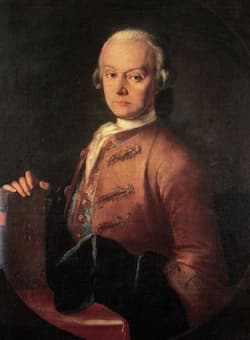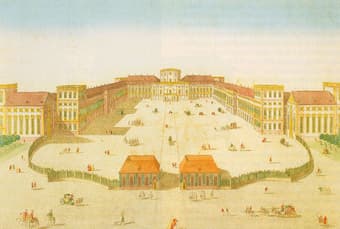Wolfgang Amadeus Mozart was born in Salzburg in current-day Austria on 27 January 1756.
He was one of the most talented prodigies in the history of music, and he grew up to become one of the most beloved and influential composers of all time.

Portrait of Mozart by Saskatoon artist Denyse Klette © DENYSE KLETTE /Saskatoon Symphony
Here are a few biographical tidbits about Mozart:
- He was one of the most famous prodigies in the history of music. As a child, he toured Europe with his older sister, who was also a jaw-droppingly talented musician. Together, the Mozart family made a big impression on royal courts across the continent.
- He was famous for his prolific output and versatility. Over the course of his life, he wrote forty-one symphonies, twenty-two operas, twenty-seven piano concertos, five violin concertos, thirty-six violin sonatas, twenty-three string quartets, and so much more.
- Mozart is considered to be one of the primary representatives of the Classical period in music, which lasted from the mid-18th century to the early 19th century. His compositions exemplify the hallmarks of the Classical style, characterized by their clarity, balance, elegance, and emotional restraint.
- His early death at the age of 35 has led to conspiracy theories that he was poisoned by a jealous rival. In fact, that assertion shapes the plot of the movie Amadeus. However, there is no real substantial evidence that any crime occurred.
Intrigued to learn more? Here are ten pieces that will help you get to know Wolfgang Amadeus Mozart better:
Symphony No. 1 (1764)
Mozart, the consummate child prodigy, wrote his first symphony at the age of eight. It was composed in England, where Mozart, his sister Nannerl, and their parents lived for a year while the children performed.

Leopold Mozart, Mozart’s father
Disaster nearly struck several times on their trip. At one point, his father fell ill, potentially fatally so. Wolfgang and his sister were told to be quiet as their father rested, and they were forced to entertain themselves.
Nannerl later remembered, “In order to occupy himself, Mozart composed his first symphony with all the instruments of the orchestra, especially trumpets and kettledrums. I had to transcribe it as I sat at his side. While he composed and I copied he said to me, ‘Remind me to give the horn something worthwhile to do!’”
That famous quote might not be referencing this specific work, since there are no kettledrums in it, but the picture certainly rings true emotionally.
Luckily, Leopold recovered, and eventually, the family returned to Salzburg.
Exsultate, jubilate (1773)
In Mozart’s day, one of the primary ways that musicians made a living was to compose for the church. Consequently, Mozart wrote a lot of religious music.
“Exsultate, jubilate” was a motet written in Milan, right before Mozart turned seventeen. It was composed for a castrato, a man who as a boy had undergone a horrifying medical procedure to keep his voice high. Castrati were necessary in sacred settings because church rules forbade women from performing.
Nowadays, women are usually the ones to perform this work, given that it is usually performed in a secular context, and church rules about women singing have relaxed.
This piece is joyful, flashy and very operatic.
Violin Concerto No. 5 (1775)
Somewhat surprisingly, given their importance to the violin repertoire, we don’t actually know exactly why a nineteen-year-old Mozart wrote any of his five violin concertos. Despite that, they’ve become bedrocks of the repertoire.
With its sophisticated elegance and myriad of contrasts, the fifth concerto is especially appealing, and generally considered to be the best among the five. It’s also the only Mozart concerto that includes a slow opening for the soloist.
Due to various political and military developments of the late eighteenth century, Austrians at the time were fascinated with Turkish culture. Mozart wrote his eighteenth-century Austrian interpretation of Turkish music into the last movement of the concerto, which you can hear at 24:20 in the video above.
Sinfonia concertante (1779)
A sinfonia concertante is a work for soloists and orchestra. Here the two soloists are a violinist and a violist.
Mozart wrote the Sinfonia Concertante while touring Europe. During that tour, he heard orchestras in Paris and Mannheim, cities known for the high quality of their instrumental performances.

Old view of Mannheim castle, Germany, 1755.
The success of this work, and his growing preoccupation with secular instrumental music generally, was one reason why he was fired from his job as court organist in Salzburg. This freed Mozart to leave for the big city of Vienna and to make a career on his own terms.
The heart of this work is its divine slow movement, which starts at 15:20 in the performance above.
Serenade No. 10 Gran Partita (1781)
In Mozart’s day, serenades were considered to be light, almost disposable music for wealthy people to use as background music at dinners or parties.
Mozart turned that convention on its head with this work, which is absurdly well-crafted and practically demands careful listening.
It’s also massive, clocking in at nearly fifty minutes.
He wrote it for a large contingent of twelve wind instruments and a double bass (which is sometimes substituted out for a bassoon).
Piano Concerto No. 21 (1785)
Over the course of his career, Mozart wrote twenty-seven piano concertos. He was one of the greatest pianists in Europe, so these pieces served as self-promotional vehicles.
Remarkably, most were composed within the span of a few years (1782-1786) while he was making a living as a freelance performer and composer in Vienna.
The most famous part of this concerto is the slow movement, which begins at 15:05 in the recording above. This slow movement made an appearance in the film Elvira Madigan.
Don Giovanni (1787)
Mozart wrote twenty-two operas. Don Giovanni is considered to be one of his masterpieces in the genre.
It follows the adventures of Don Giovanni, a wealthy nobleman who claims to have slept with over two thousand women, and who has taken advantage of many of them.
The opera ends with his refusing to repent and being dragged down to hell in a terrifying supernatural sequence.
The dramatic thrills of this finale look forward to the themes and more overt emotions of the Romantic era.
Gustave Flaubert famously called Don Giovanni, along with Hamlet and the sea, the three greatest things that God had ever made. He definitely had a point!
Serenade No. 13 (1787)
Officially this work is titled Serenade No. 13, but you probably know it as Eine kleine Nachtmusik (“A Little Night Music” in German).
We don’t know why it was written, or for who, but it was likely a commission by an aristocratic patron.
Interestingly, it was not published until 1827, years after Mozart’s death, and yet today it is one of his most famous works.
Symphony No. 41 (1788)
This is the last of Mozart’s symphonies. It is staggering to compare this work’s complexity with the first symphony that Mozart wrote as a little boy. There is no comparison.
The music strains hard against the limits of restrained classical era convention. Its fourth movement contains one of the most famous fugues in classical music history (it starts at 22:55 in the recording above). In it, a full five themes are woven together simultaneously.
The whole thing is a veritable outburst of joy. It’s so tempting to imagine what other symphonies he might have written had he only lived longer.
Requiem (1791)
The story of Mozart’s Requiem is full of intrigue.
In 1791, a count named Franz von Walsegg commissioned Mozart to write a Requiem in honor of his recently deceased wife. However, the count had an ulterior motive: he was an amateur musician, and he wanted to buy a work that he could pass off as his own.
Mozart accepted the commission but died at the age of 35 before it could be finished. His widow, left with two children to raise and needing money, hired another composer named Franz Xaver Süssmayr to finish it.
The circumstances behind Mozart’s death have been hotly debated. While there is no evidence that he was poisoned, that hasn’t kept rumors from flying for generations. In fact, as we mentioned in the introduction, those rumors served as the basis of the plot of the 1984 movie Amadeus.
Apart from the history and the legend, it’s worth remembering that the music itself is towering and unforgettable. It is the most heartfelt, majestic ending imaginable to an extraordinary career.
For more of the best in classical music, sign up for our E-Newsletter

